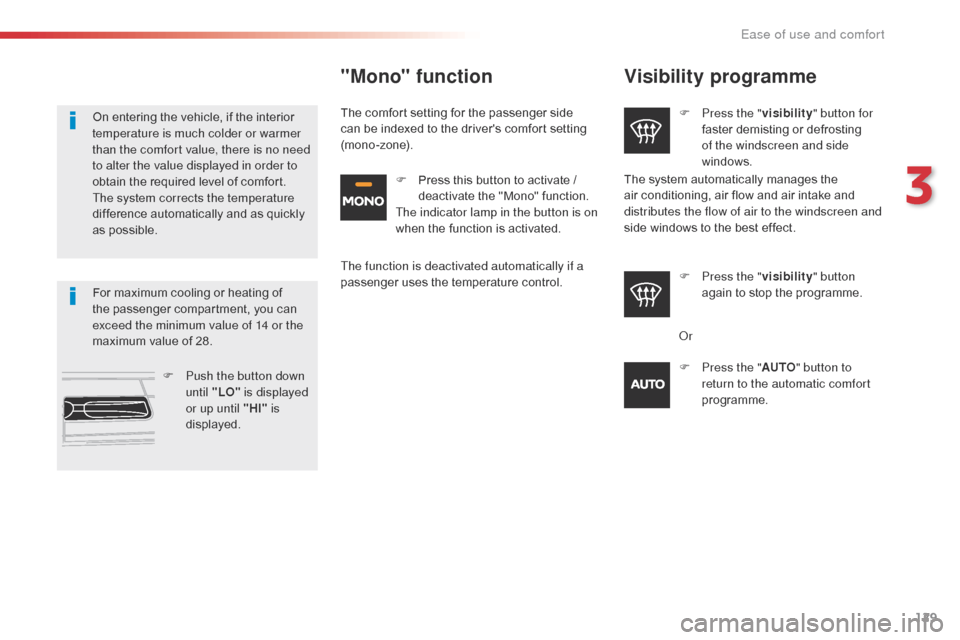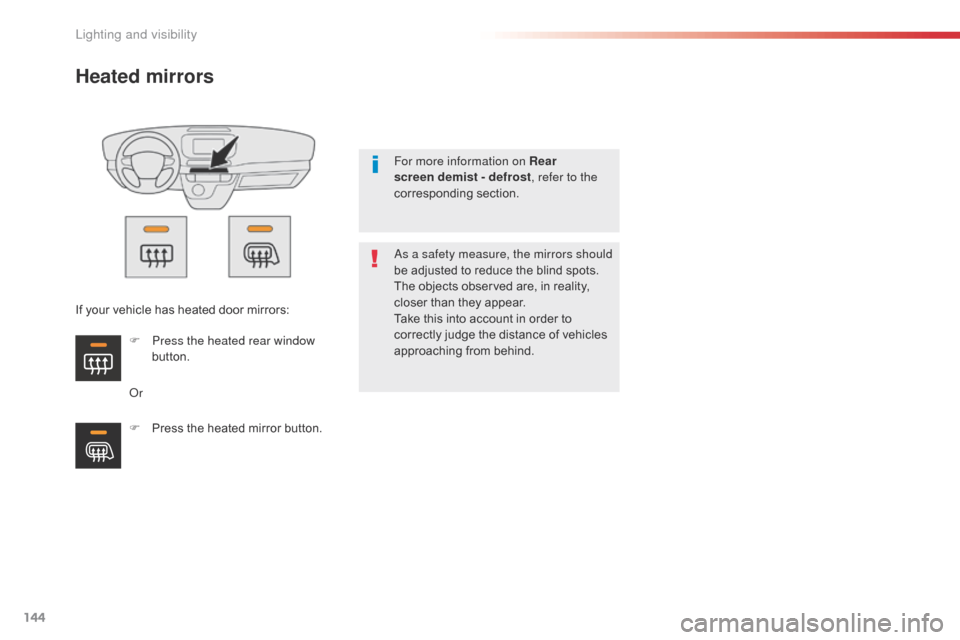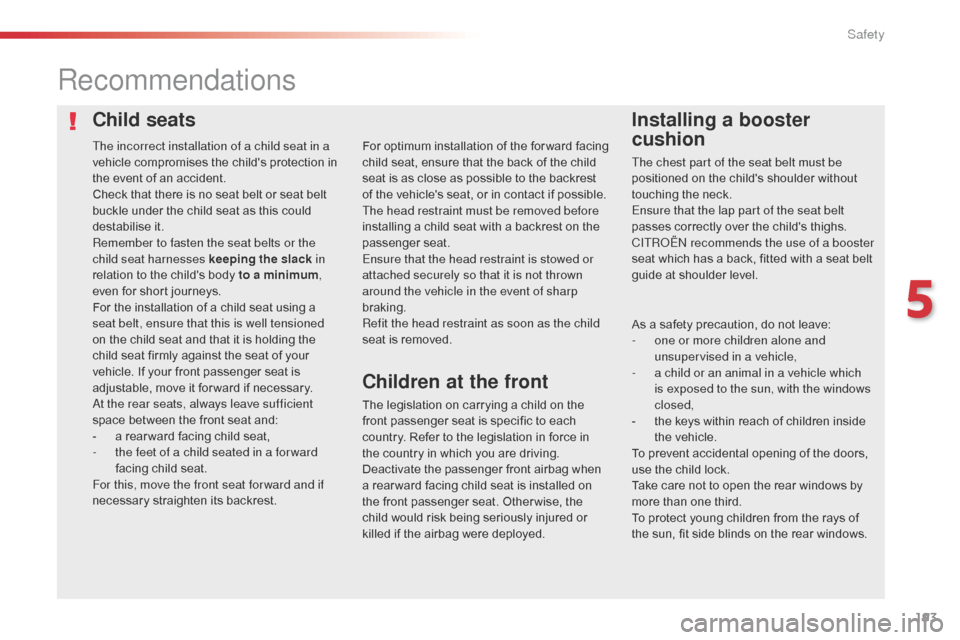Window Citroen JUMPY 2016 2.G Owner's Guide
[x] Cancel search | Manufacturer: CITROEN, Model Year: 2016, Model line: JUMPY, Model: Citroen JUMPY 2016 2.GPages: 595, PDF Size: 12.47 MB
Page 129 of 595

127
Jumpy _en_Chap03_ergonomie-et-confort_ed01-2016
Air conditioning
Switching on
With the engine running, the air conditioning is
designed to operate effectively in all seasons,
with the windows closed.
It enables you to:
-
l
ower the temperature, in summer,
-
i
ncrease the effectiveness of the demisting
in winter, above 3°C.
To obtain cool air more quickly, you
can use interior air recirculation for
a few moments. Then return to the
intake of exterior air. F
P
ress this button; its indicator
lamp comes on. F
P
ress this button again; its
indicator lamp goes off.
Switching off
The air conditioning does not operate
when the air flow adjustment is set
to
off. Switching off may result in some
discomfort (humidity, misting).
3
Ease of use and comfort
Page 130 of 595

128
Jumpy _en_Chap03_ergonomie-et-confort_ed01-2016
A setting around 21 enables you to
obtain an optimum level of comfort.
Depending on your requirements, a
setting between 18 and 24 is usual.
In addition, it is recommended that you
avoid a left /right setting difference of
more than 3.
Dual-zone automatic air conditioning
Offers the best compromise between
a comfortable temperature and quiet
operation.
Provides soft and quiet operation by
limiting air flow. Provides strong and effective air flow.
F
P
ress the "AUTO"
button
repeatedly.
Automatic comfort mode TemperatureF Push the button down to
reduce the value or up to
increase it.
When the engine is cold, the air flow will
only reach its optimum level gradually
to prevent too great a distribution of
cold air.
In cold weather, it favours the
distribution of warm air to the
windscreen, the side windows and the
footwells only.
The active mode appears in the display screen,
as described below:
If desired, you can choose settings different
to those offered by the system, by adjusting a
setting manually. The other functions are still
managed automatically.
The "AUTO " symbol disappears if you modify
a setting.
Manual mode
The driver and front passenger can each set
the temperature to suit their requirements.
The value indicated in the screen corresponds
to a level of comfort and not to a temperature in
degrees Celsius or Fahrenheit.
Ease of use and comfort
Page 131 of 595

129
Jumpy _en_Chap03_ergonomie-et-confort_ed01-2016
Visibility programme
F Press the "visibility" button for
faster demisting or defrosting
of the windscreen and side
windows.
F
P
ress the " visibility" button
again to stop the programme.
The system automatically manages the
air conditioning, air flow and air intake and
distributes the flow of air to the windscreen and
side windows to the best effect.
For maximum cooling or heating of
the passenger compartment, you can
exceed the minimum value of 14 or the
maximum value of 28. F
P
ush the button down
until "LO" is displayed
or up until "HI" is
displayed.
On entering the vehicle, if the interior
temperature is much colder or warmer
than the comfort value, there is no need
to alter the value displayed in order to
obtain the required level of comfort.
The system corrects the temperature
difference automatically and as quickly
as possible.
"Mono" function
The comfort setting for the passenger side
can be indexed to the driver's comfort setting
(mono-zone).
The function is deactivated automatically if a
passenger uses the temperature control.
Or
F
P
ress the "AUTO" button to
return to the automatic comfort
programme.
F
P
ress this button to activate /
deactivate the "Mono" function.
The indicator lamp in the button is on
when the function is activated.
3
Ease of use and comfort
Page 132 of 595

130
Jumpy _en_Chap03_ergonomie-et-confort_ed01-2016
F Press this button to increase air f low.
Air distribution
F Press this button repeatedly to direct the air flow in turn to:
-
t
he windscreen, the side windows and the
footwells,
-
t
he footwells,
-
t
he central vents, the side vents and the
footwells,
-
t
he windscreen, the side windows, the
centre vents and the footwells,
-
t
he centre and side vents,
-
t
he windscreen and side windows
(demisting or defrosting).
Air flow
F Press this button to decrease air f low.
The air flow symbol (a fan) appears. It is filled
in or emptied progressively according to the
setting.
Air conditioning
It enables you to:
- l ower the temperature, in summer,
-
i
ncrease the effectiveness of the demisting
in winter, above 3°C.
Switching on
With the engine running, the air conditioning is
designed to operate effectively in all seasons,
with the windows closed.
The air conditioning does not operate
when the air flow adjustment is set
to
off.To obtain cool air more quickly, you
can use interior air recirculation for
a few moments. Then return to the
intake of exterior air. F
P
ress this button; its indicator
lamp comes on.
F
P
ress this button again; its
indicator lamp goes off.
Switching off
Switching off may result in some
discomfort (humidity, misting).
Ease of use and comfort
Page 133 of 595

131
Jumpy _en_Chap03_ergonomie-et-confort_ed01-2016
Switching the system off
F Press this button until the fan symbol disappears.
This action switches off all of the functions of
the system.
The temperature is no longer controlled. A
slight flow of air, resulting from the movement
of the vehicle, remains perceptible however. Avoid driving for too long with the
system switched off (risk of misting and
of deterioration of the air quality).
Air intake / Air recirculation
The intake of exterior air avoids misting of the
windscreen and side windows.
The recirculation of interior air insulates the
passenger compartment from exterior odours
and smoke.
Return to exterior air intake as soon as
possible to avoid deterioration of the air
quality and the formation of mist.This allows hot or cold air to be
delivered quickly when required.
F
P
ress this button to recirculate
the interior air; the symbol
appears.
F
P
ress this button again to allow
exterior air into the passenger
compartment; the symbol
disappears. F
P
ress this button to switch the
system on again.
3
Ease of use and comfort
Page 134 of 595

132
Jumpy _en_Chap03_ergonomie-et-confort_ed01-2016
Front demist - defrost
These markings on the control panel indicate the control positions for rapid demisting or
defrosting of the windscreen and side windows.
Manual heating/ventilation
or air conditioning
With Stop & Start, when demisting has
been activated, the STOP mode is not
available.
Dual-zone digital air
conditioning
F Put the air flow, temperature and distribution controls to the dedicated
marked position. The system automatically manages the air
conditioning, air flow and air intake, and
provides optimum distribution towards the
windscreen and side windows.
The system reverts to the previous settings. F
P
ress this button to demist or
defrost the windscreen and side
windows as quickly as possible.
F
T
o stop, press this button again
or on "AUTO".
F
F
or air conditioning, press
this button; its indicator lamp
comes
on. Heated windscreen and washer jets
For more information on the Wiper
control stalk
and in particular the
heated windscreen and washer jets,
refer to the corresponding section.
Ease of use and comfort
Page 146 of 595

144
Jumpy _en_Chap04_eclairage-et-visibilite_ed01-2016
Heated mirrors
OrAs a safety measure, the mirrors should
be adjusted to reduce the blind spots.
The objects observed are, in reality,
closer than they appear.
Take this into account in order to
correctly judge the distance of vehicles
approaching from behind.
For more information on Rear
screen demist - defrost , refer to the
corresponding section.
F
P
ress the heated rear window
button.
F
P
ress the heated mirror button.
If your vehicle has heated door mirrors:
Lighting and visibility
Page 195 of 595

193
Jumpy _en_Chap05_securite_ed01-2016
Child seatsInstalling a booster
cushion
Recommendations
The legislation on carrying a child on the
front passenger seat is specific to each
country. Refer to the legislation in force in
the country in which you are driving.
Deactivate the passenger front airbag when
a rear ward facing child seat is installed on
the front passenger seat. Otherwise, the
child would risk being seriously injured or
killed if the airbag were deployed. For optimum installation of the forward facing
child seat, ensure that the back of the child
seat is as close as possible to the backrest
of the vehicle's seat, or in contact if possible.
The head restraint must be removed before
installing a child seat with a backrest on the
passenger seat.
Ensure that the head restraint is stowed or
attached securely so that it is not thrown
around the vehicle in the event of sharp
braking.
Refit the head restraint as soon as the child
seat is removed.
The incorrect installation of a child seat in a
vehicle compromises the child's protection in
the event of an accident.
Check that there is no seat belt or seat belt
buckle under the child seat as this could
destabilise it.
Remember to fasten the seat belts or the
child seat harnesses keeping the slack in
relation to the child's body to a minimum
,
even for short journeys.
For the installation of a child seat using a
seat belt, ensure that this is well tensioned
on the child seat and that it is holding the
child seat firmly against the seat of your
vehicle. If your front passenger seat is
adjustable, move it for ward if necessary.
At the rear seats, always leave sufficient
space between the front seat and:
-
a r
ear ward facing child seat,
-
t
he feet of a child seated in a for ward
facing child seat.
For this, move the front seat for ward and if
necessary straighten its backrest.
Children at the front
The chest part of the seat belt must be
positioned on the child's shoulder without
touching the neck.
Ensure that the lap part of the seat belt
passes correctly over the child's thighs.
CITROËN recommends the use of a booster
seat which has a back, fitted with a seat belt
guide at shoulder level.
As a safety precaution, do not leave:
-
o
ne or more children alone and
unsupervised in a vehicle,
-
a c
hild or an animal in a vehicle which
is exposed to the sun, with the windows
closed,
-
t
he keys within reach of children inside
the vehicle.
To prevent accidental opening of the doors,
use the child lock.
Take care not to open the rear windows by
more than one third.
To protect young children from the rays of
the sun, fit side blinds on the rear windows.
5
Safety
Page 197 of 595

195
Jumpy _en_Chap05_securite_ed01-2016
Child lock
on rear
windows
This mechanical system prevents opening of
the left and/or right rear side windows.
F
L
ock /unlock the system using the remote
control or the back-up key of the Keyless
Entry and Starting system.
Any other status of the indicator lamp
indicates a fault with the electric child
lock.
Have it checked by a CITROËN dealer
or a qualified workshop. In the event of a serious impact, the
electric child lock is deactivated (child
lock off) automatically.
This system is independent and in no
circumstances does it take the place of
the central locking control.
Do not drive with the sliding side door
open.
Check the status of the child lock each
time you switch on the ignition.
Always remove the key from the ignition
when leaving the vehicle, even for a
short time.
5
Safety
Page 263 of 595

261
Jumpy _en_Chap06_conduite_ed01-2016
Activation
Activation is automatic on engaging reverse.
The function is displayed in the touch screen.
To close the window displayed, press on the
red cross at the top left of the screen.On display of the sub-menu, select one of the
four views:
"Standard view".
"180° view".
"Zoom view".
"AUTO mode".
You can choose the display mode at any time
by pressing on this area. Check the cleanliness of the camera
lenses regularly.
Periodically clean the reversing camera
with a soft dry cloth.
"AUTO mode"
This mode is activated by default.
Using sensors in the rear bumper, the
automatic view allows a change from the rear
view to the view from above as an obstacle is
approached during a manoeuvre.
The system is automatically deactivated
when towing a trailer or carrying a
bicycle on the towbar (vehicle fitted with
a towbar installed as recommended by
the manufacturer).
Quick start mode
This mode displays, as quickly as possible, the
contextual view (left-hand part) and the view
from above the vehicle. High pressure jet wash (if muddy,
for
example)
When washing your vehicle, do not
place the tip of the lance within 30 cm of
the camera lenses, as otherwise there
is a risk of damaging them.
A message is displayed advising you to check
your vehicle's surroundings before starting the
manoeuvre.
6
Driving